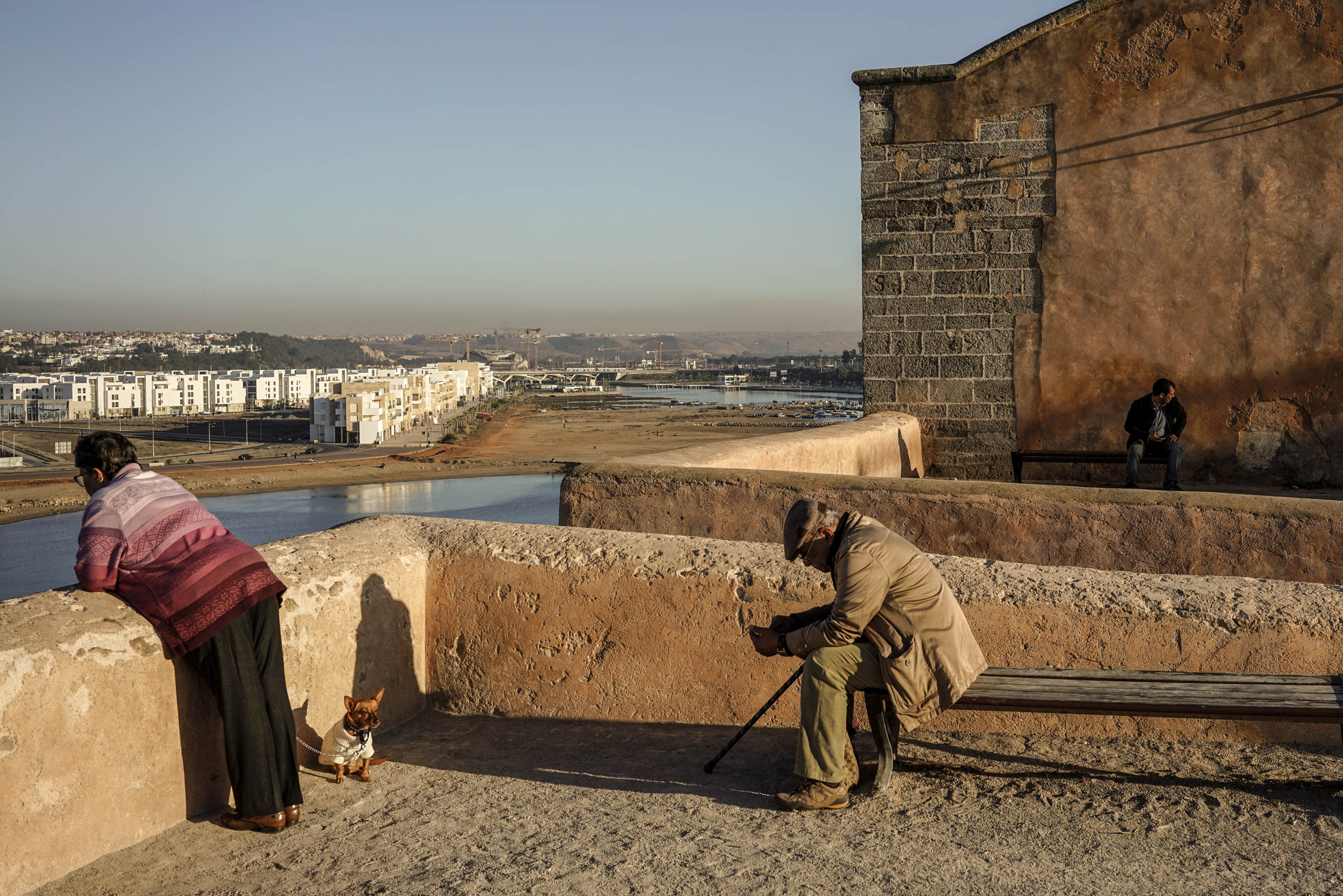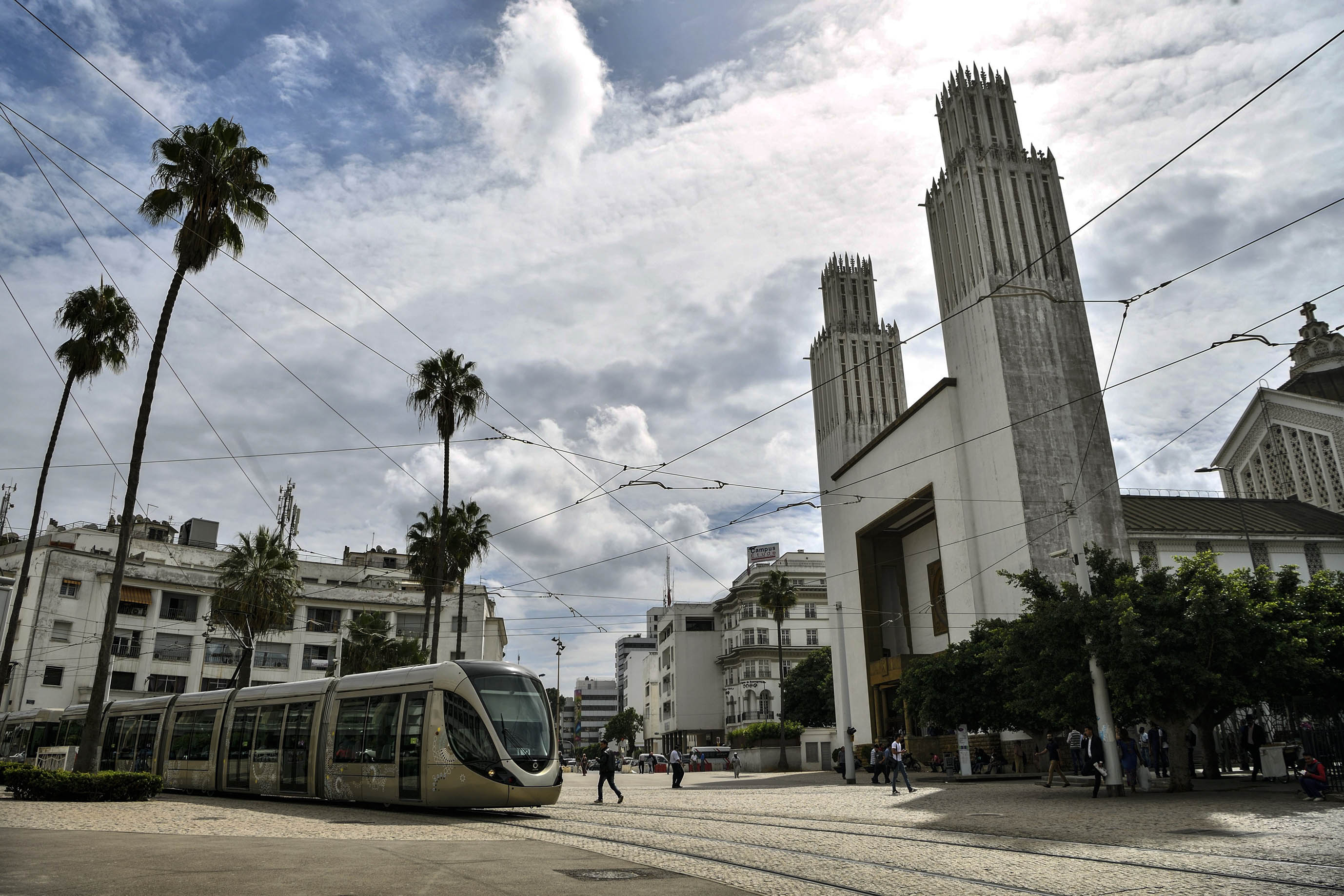The Mohammed VI Bridge, the longest cable-stayed bridge in Africa, stretches over the Bou Regreg valley connecting the cities of Rabat and Salé. (Fadel Senna/AFP)
Rabat and Salé — On either side of the river Bou Regreg, on the coast where it empties into the Atlantic Ocean, lie the sister cities of Rabat and Salé. Despite their proximity, centuries of feuding, colonial scheming and well-intentioned housing policy have created two very different urban environments.
One, la ville lumiere, the city of light, is the kingdom’s capital, the jewel of 21st century Morocco. It is clean and cosmopolitan, and boasts modern public transport, a stable water supply and constant electricity. Its elegant avenues are lined with palm trees, and the architecture is a wonderful blend of modern and traditional Islamic aesthetics. It is the epitome of the modern, confident, prosperous image that Morocco presents to international tourists and — more importantly — investors.
Few non-Moroccans would be able to name Salé, though it is nearly double Rabat’s size, with about one million residents to Rabat’s population of 580 000. The city has few amenities or services outside of the basics. It is known as la ville dortoir — the dormitory town. Although its medina, or old town, is still enclosed by the original four walls, the rest of the city is less impressive, its worn-down apartment buildings reflecting the ad hoc nature of its development. Salé has become an appendage on Rabat’s periphery: the functional backyard to Rabat’s glowing shop front.

Property development in Salé is visible from the wall of Rabat. (René Mattes/hemis.fr)
It wasn’t always like this. Founded in about 1030 by Berbers, Salé’s fortunes rose and fell with the pirates who dominated the Moroccan portion of the Mediterranean. By the 17th century it was a haven for Barbary pirates and traders who formed the independent Republic of Bou Regreg in 1627, which encompassed both cities. Rabat, an outpost for troops at the time, remained the less successful, less cultural city until the turn of the 20th century when the French arrived.
General Louis Hubert Lyautey, the French colonial administrator, decided to create a new capital for Morocco in Rabat because of its strategic location, historical royal links and development potential. Sultan Moulay Youssef followed Lyautey’s thinking and moved his residence to the city, cementing Rabat’s position as the new centre.
The French introduced the concept of ville nouvelle (new city) as a means of socioeconomic control, choosing which cities would move into the 20th century and which would be left behind. Ancient Salé did not receive the stamp of approval.
“Salé had strong thinkers that drove the resistance against the colonisers,” said Hassan Benzalla, director of the Salamoustaqbal Association, a civil society group in Salé. “This is why it was historically isolated.”
Historian Mohammed Krombi revealed how Moroccan cities with a similar fate perished to nonrelevance and that “Salé only survived and grew because of its proximity to Rabat”.
The colonial influence in Morocco was greatly shaped by the fact that the country was a protectorate. This caused the French to recognise the traditional Moroccan society upon which they depended for control, while applying French schools of thought across the county’s administration services.
Post-independence, the infrastructure left by the French led Rabat to become the hub of economic and political power in the region, with a network of satellite cities on its periphery. All the jobs and services were concentrated in Rabat, and the formerly tightly knit social fabric of cities such as Salé began to unwind as elites moved to Rabat, just as the sultan had done years before.
During the 1980s and 1990s, Rabat experienced significant growth, and its urban pressure spilt over into the surrounding areas, including Salé, as well as Témara, Tamesna and Kénitra. These satellite cities are reservoirs of skilled human capital that serve Rabat. They offer cheaper property and living costs, but less amenities and services. The development of a commuting culture into Rabat has meant that the population of these cities continues to rise, and Rabat’s has remained stagnant.
The relationship between the two cities took another turn in the early 2000s, when Morocco became embroiled in the war on terror. Shanty towns, known as bidonvilles, became the recruiting grounds for international terror organisations. Morocco itself was not spared: in 2003, Casablanca was hit with co-ordinated suicide bombings in five locations, killing 33 civilians as well as 12 attackers.
In 2005, the king launched the national initiative for human development to address the underlying socioeconomic conditions in the bidonvilles. The initiative was driven by public-private partnerships and included the programme Villes sans Bidonvilles, a national initiative to rid cities of slums. Through this programme, citizens living in slum conditions in the city centre were moved to new housing developments. The high costs of urban land meant that most of the new developments were located in the urban periphery, in some cases as far as 20km from the city centre.
The programme has been a great success in reducing the percentage of Moroccans living in unsuitable housing conditions: from 8.2% in 2004 to 3.9% in 2010. But, the project has had the unintended consequence of pushing poor people outside of major city centres, including Rabat, leaving them on the periphery in economically underdeveloped areas such as Salé.
The increase in inequality hasn’t gone unnoticed, however. Also in 2005, King Mohammed VI developed the independent Bouregreg Valley Development Agency, with a mandate to bring Rabat and Salé closer together through major investment in cultural, infrastructure and transport projects.
Since its inception, the agency has been responsible for the development of seven bridges between the cities, the Oudayas tunnel, the flagship Rabat-Salé tramway and the Bouregreg Marina. The agency has also led high-profile projects that put the region on the global map, namely Grand Théâtre de Rabat designed by architect Zaha Hadid and the Rabat Tower, which, once completed, will be the tallest skyscraper in Africa.

The new Rabat-Salé tramway in Rabat. (David Degner/Getty Images)
In another context, one where city identities hadn’t been developed over centuries, Salé may have simply been absorbed into Rabat, turning into a lower-income neighbourhood of the capital. But those identities have informed the development of both cities, creating and reinforcing inequalities along the way, and meaning that no matter which direction you cross over Bou Regreg, you will always end up in a different place.
Nchimunya Hamukoma leads research for the Brenthurst Foundation’s Future of African Cities series. This article is based on a longer discussion paper available at thebrenthurstfoundation.org. Special thanks to researchers Nicola Doyle and Archimedes Muzenda, as well translators Adesola Sekumade and Zakia Stili